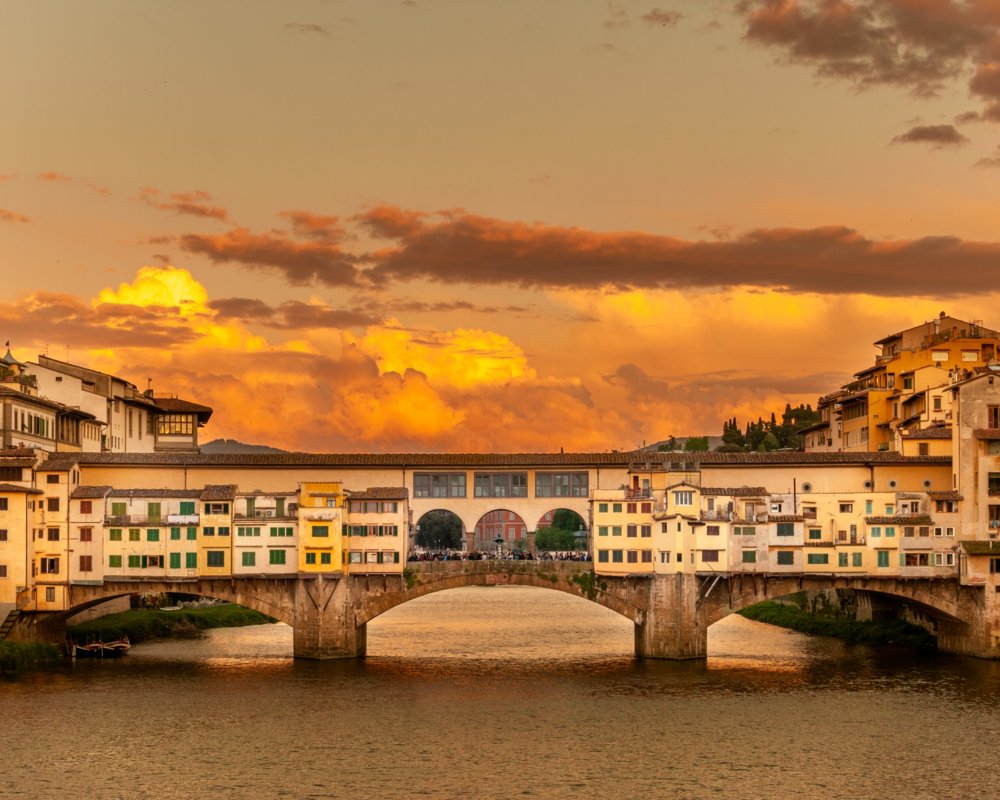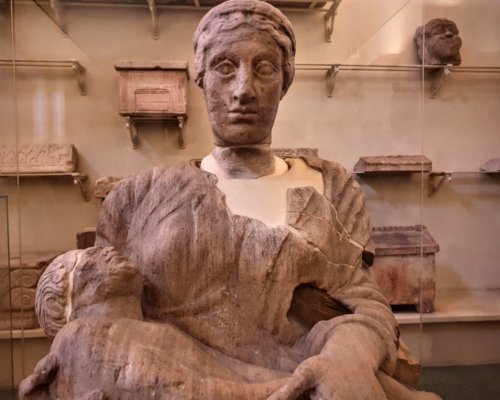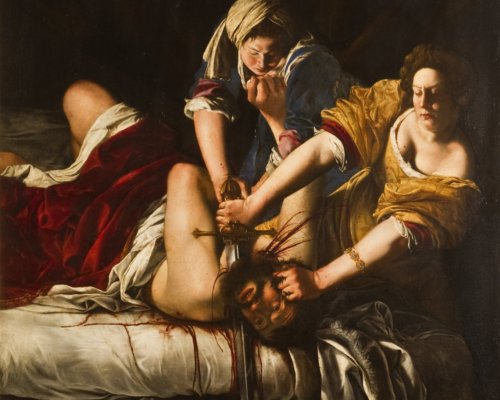Itinerary to discover 3 female figures in the museums of Florence
This journey begins in the distant past and follows in the footsteps of pre-Roman divinities, a symbol of prosperity (at that time Etruscan women were already very independent and part of society) before reaching the paintings by artists who left their mark with prodigious works that continue to "talk". We explore an amazing, rebellious painter who was inspired by the works of Caravaggio, and a nun who learned to paint religious images like - if not better - than men, without any guidance.
Florence is home to the legacy of 3 figures; one is symbolic, and the others truly existed.
Follow this feminine itinerary through 3 important museums to immerse yourself in the pages of art history and archeology that you may not yet know.
Mater Matuta (meaning "mother of the morning") was a divinity venerated as a propitious mother and goddess of fertility who was the beginning of all things and therefore of dawn. She is a true symbol of the matriarchy. Lucretius also speaks of her in De rerum natura (“Thus at a fixed hour Matuta suffuses the shores of the ether with the rosy light of the dawn and spreads the light”). In her honour, the Matralias were celebrated; these were feasts in which free women participated, both those who were virgins and those who were married.
At the Archaeological Museum of Florence, we find a beautiful funerary statue depicting Mater Matuta coming from the Chiusi-Chianciano Terme area that dates to the 5th century BC. Funerary statues are generally sculptures in full relief with a small cavity inside the head used to preserve the ashes of the deceased.
The female figure has her hair tied up and held by a ribbon and she wears a draped robe with large folds on the knees. She sits on a throne with armrests in the shape of sphinxes, holding a child wrapped in swaddling clothes. Other similar sculptures are known in ancient times, for example in Rome where the temple of Mater Matuta stood near the port of the Tiber, as if to protect the main trade route, suggesting how much this divinity was revered.
Mater Matuta (meaning "mother of the morning") was a divinity venerated as a propitious mother and goddess of fertility who was the beginning of all things and therefore of dawn. She is a true symbol of the matriarchy. Lucretius also speaks of her in De rerum natura (“Thus at a fixed hour Matuta suffuses the shores of the ether with the rosy light of the dawn and spreads the light”). In her honour, the Matralias were celebrated; these were feasts in which free women participated, both those who were virgins and those who were married.
At the Archaeological Museum of Florence, we find a beautiful funerary statue depicting Mater Matuta coming from the Chiusi-Chianciano Terme area that dates to the 5th century BC. Funerary statues are generally sculptures in full relief with a small cavity inside the head used to preserve the ashes of the deceased.
The female figure has her hair tied up and held by a ribbon and she wears a draped robe with large folds on the knees. She sits on a throne with armrests in the shape of sphinxes, holding a child wrapped in swaddling clothes. Other similar sculptures are known in ancient times, for example in Rome where the temple of Mater Matuta stood near the port of the Tiber, as if to protect the main trade route, suggesting how much this divinity was revered.
Feminists around the world consider Artemisia Gentileschi's art to be a manifesto of liberation from patriarchy. The work depicts the heroic act of Judith as she led Israel to the liberation of her people. Presenting herself to the camp of Holofernes, head of the enemy army, Judith staged an attempt at conciliation and alliance. Holofernes invited her to a banquet in his tent as he was struck by her beauty. Once asleep and drunk with wine, "God struck him by the hand of a woman" (quoting the Bible): Judith stole his scimitar and beheaded him.
In the famous and powerful painting preserved in the Uffizi Galleries that dates to around 1620, Artemisia Gentileschi represents a forceful and fearless Judith as she grabs Holofernes' head by the hair and strikes her fatal blow. The abundant gushing blood underlines the bloodiness of the gesture.
In addition to representing a biblical episode, the work also symbolizes the (not easy) choice of a woman who wanted to become an artist in a world dominated by men, managing to make a place in history thanks to her great talent. Just think about the fact that she was the first woman ever to enter the Academy of Arts and Design in Florence.
Feminists around the world consider Artemisia Gentileschi's art to be a manifesto of liberation from patriarchy. The work depicts the heroic act of Judith as she led Israel to the liberation of her people. Presenting herself to the camp of Holofernes, head of the enemy army, Judith staged an attempt at conciliation and alliance. Holofernes invited her to a banquet in his tent as he was struck by her beauty. Once asleep and drunk with wine, "God struck him by the hand of a woman" (quoting the Bible): Judith stole his scimitar and beheaded him.
In the famous and powerful painting preserved in the Uffizi Galleries that dates to around 1620, Artemisia Gentileschi represents a forceful and fearless Judith as she grabs Holofernes' head by the hair and strikes her fatal blow. The abundant gushing blood underlines the bloodiness of the gesture.
In addition to representing a biblical episode, the work also symbolizes the (not easy) choice of a woman who wanted to become an artist in a world dominated by men, managing to make a place in history thanks to her great talent. Just think about the fact that she was the first woman ever to enter the Academy of Arts and Design in Florence.
Polissena de 'Nelli, later known as Plautilla, entered the convent of Santa Caterina at the age of 14. Here, the Dominican nun was completely self-taught in the art of painting, copying works and drawings and using her fellow sisters as models. She had never worked in any workshop nor had she taken anatomical drawing lessons (forbidden to women at the time).
Plautilla was able to create grandiose and highly appreciated works, particularly with a religious theme. Her Last Supper is one of the most significant paintings in the history of art. This extraordinary painting is the first and perhaps only representation of the Last Supper by an artist who lived in the Renaissance period. The large-sized work (7 metres long and 2 metres high), features life-size painted figures.
Thanks to an important restoration work, it's now visible to all in the Santa Maria Novella Museum.
Polissena de 'Nelli, later known as Plautilla, entered the convent of Santa Caterina at the age of 14. Here, the Dominican nun was completely self-taught in the art of painting, copying works and drawings and using her fellow sisters as models. She had never worked in any workshop nor had she taken anatomical drawing lessons (forbidden to women at the time).
Plautilla was able to create grandiose and highly appreciated works, particularly with a religious theme. Her Last Supper is one of the most significant paintings in the history of art. This extraordinary painting is the first and perhaps only representation of the Last Supper by an artist who lived in the Renaissance period. The large-sized work (7 metres long and 2 metres high), features life-size painted figures.
Thanks to an important restoration work, it's now visible to all in the Santa Maria Novella Museum.


